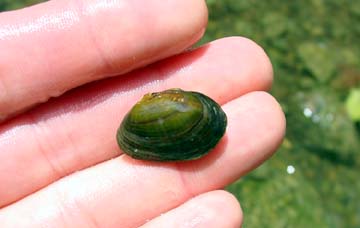By HALEY WALKER
Capital News Service
LANSING – Two funny-named mussels found in rivers of the Great Lake region are in line for Endangered Species Act protection.

Rayed Bean Mussel (credit: U.S. Fish and Wildlife Service)
The rayed bean and snuffbox mussels are threatened by the adverse effects of chemical contaminants, sedimentation and mining on their habitat’s water quality, according to the U.S. Fish and Wildlife Service, which has proposed endangered species status for them.
“Most of the impacts to their habitat are from human activities,” said Angela Boyer, an endangered species coordinator with the federal agency, who drafted the proposal. “Mussels need very clean water to survive.”
The rayed bean lives in rivers in Michigan, Indiana, Ontario, Ohio, New York and Pennsylvania – all of which border the Great Lakes — as well as in West Virginia.
It gets its name from its small size and its wavy green rays.
Once found in Lake Erie and 111 streams across the United States, the rayed bean population has suffered a 75 percent decline and now lives in only 28 streams and Lake Erie.
In the Great Lakes region, the snuffbox mussel lives in Michigan, Illinois, Indiana, Michigan, Pennsylvania, Minnesota, Wisconsin and Ohio. They also exist in rivers in Alabama, Arkansas, Kentucky, Tennessee, Virginia and West Virginia.
It’s triangular-shaped, similar to the place on the human hand between the wrist and the base of the thumb that’s called the snuffbox.
Formerly prevalent in 208 streams nationwide, it’s now known in only 74.
“The snuffbox is not doing well in a lot of streams that it used to be,” said Boyer. “The numbers are hanging on.”
Mussels are important indicators of water quality. North America has some of the greatest diversity of mussels in the world, but 70 percent are extinct or imperiled, according to the Nature Conservancy.
There are more than 78 known species of mussels in the Midwest. Half are considered threatened or endangered.
“They are kind of like the canary in the coal mine as far as water goes,” said Georgia Parham, a public affairs specialist with the Fish and Wildlife Service. “The fact that these species are declining and in need of listing is actually an indicator of our own water quality.”
Many times the streams where mussels exist also provide a public water supply, according to Parham.
Mussels also help stabilize riverbeds by burrowing in the bottom.
Boyer said, “This is telling us that there is something wrong because the species that are supposed to be there are not.
Meanwhile, the federal agency is asking for any studies that show population trends or size of the two species, as well as information on current or foreseeable threats to them.
Parham said, “The fact that we are proposing it for listing indicates that we have information that says it should be listed. But we can’t do that before we go through the public comment period.”
An official designation as engendered would make it illegal for anyone to knowingly kill or harm them, Boyer said. It would also mean that federal agencies need the Fish and Wildlife Service to make sure that federally funded projects don’t harm them.
If the mussels become listed, the Fish and Wildlife Service would develop a recovery plan that sets steps for how the species populations recover so protection will no longer be warranted.
“If we lose these species, they are irreplaceable,” said Boyer. “Extinction is forever.”
(Haley Walker writes for Great Lakes Echo.)
© 2010, Capital News Service, Michigan State University School of Journalism. Not to be reproduced without permission.